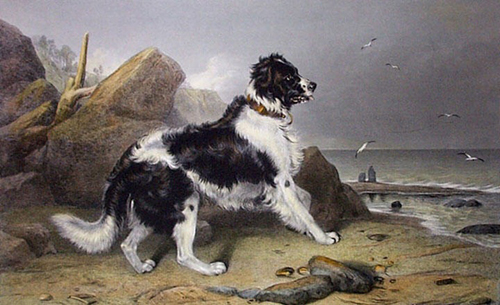 Off to the Rescue
Off to the Rescue (1827)
by
Sir Edwin Landseer
This painting by Landseer (1802 - 1873) is formally known as Bashaw, the Property of the Right Honourable Earl of Dudley; it acquired the more common title of Off to the Rescue when it was engraved for the mass market. This is the same Bashaw who is portrayed in Matthew Wyatt's sculpture of a Newfoundland trampling a snake. (The Earl, needless to say, was obviously very fond of this dog — a lá Byron, one might say....)
More about Bashaw, whose importance in Newfiedom goes beyond being the subject of what I believe is the very first statue of a Newfoundland as well as the first Newf (to my knowledge) who was the subject of BOTH a painting and a sculpture:
On May 29, 1829, there appeared in the London Times newspaper a "lost dog" notice regarding a black-and-white Newfoundland who responded to the name "Bashaw." I strongly suspect this is the same dog depicted in Landseer's painting, for in the Victoria and Albert museum's description of the Wyatt statue mentioned above, the dog's owner is specifically identified as John William Ward, the 1st Earl Dudley, who lived in Park Lane, London, which is precisely where the dog in the newspaper notice was reported missing. At least we know this particular Bashaw was found and returned to its owner, since Wyatt's statue of Bashaw wasn't begun until several years after the "lost Newf" notice appeared. (It may also be worth noting that the reward offered for Bashaw's return was two guineas — approximately $240 US in 2020 — which was at least double the usual reward offered for Newfoundlands at this time, strongly indicating the lost Newf belonged to a well-to-do owner.)
Bashaw's name will appear again in the London Times, in July of 1834, in an announcement that the statue is available for public viewing. I imagine this was an attempt by Wyatt to recoup some of the cost of the statue's creation, as Bashaw's owner, the Earl of Dudley, had died the year before without paying for the statue.
Bashaw's name will be invoked in The Times on several occasions in 1836, when the hucksterish London dog seller J. S. Pardy will post several advertisements offering "Some splendid Newfoundlands and Whelps, got by the Great Bashaw." Pardy will even, in October of 1836, offer for sale "the Young Bashaw," though whether that dog truly was a son of the original Bashaw (who would have been at least 10 years old by this time) or was simply a huckster's claim may never be known.
Despite any uncertainty, all of this clearly indicates that "Bashaw" was a name to conjure with in England in the 1830s, the heyday of the popularity of the Newfoundland. Even 30 years on, the statue of Bashaw was singled out for particular notice in the obituary of Matthew Cotes Wyatt, the sculptor, when he passed away in 1862.

